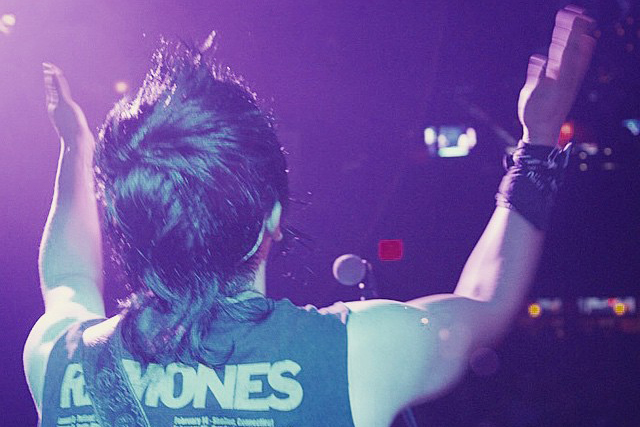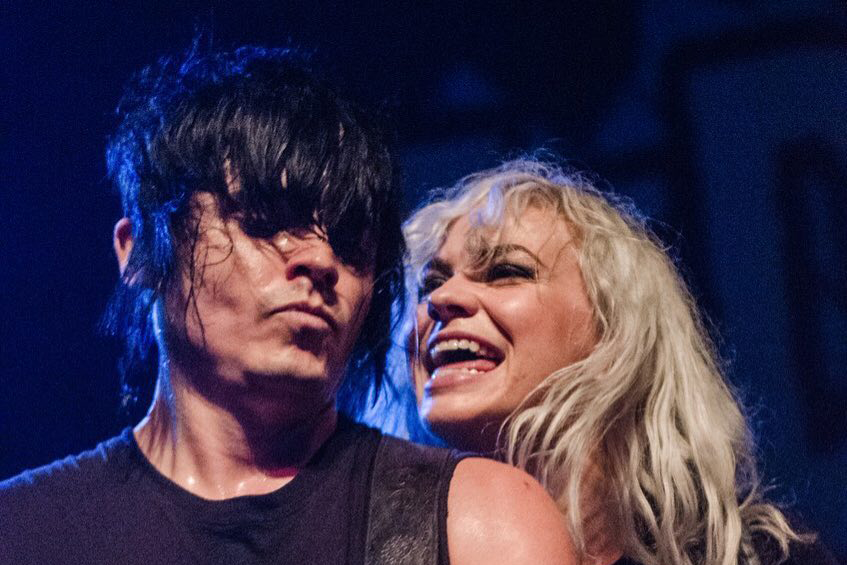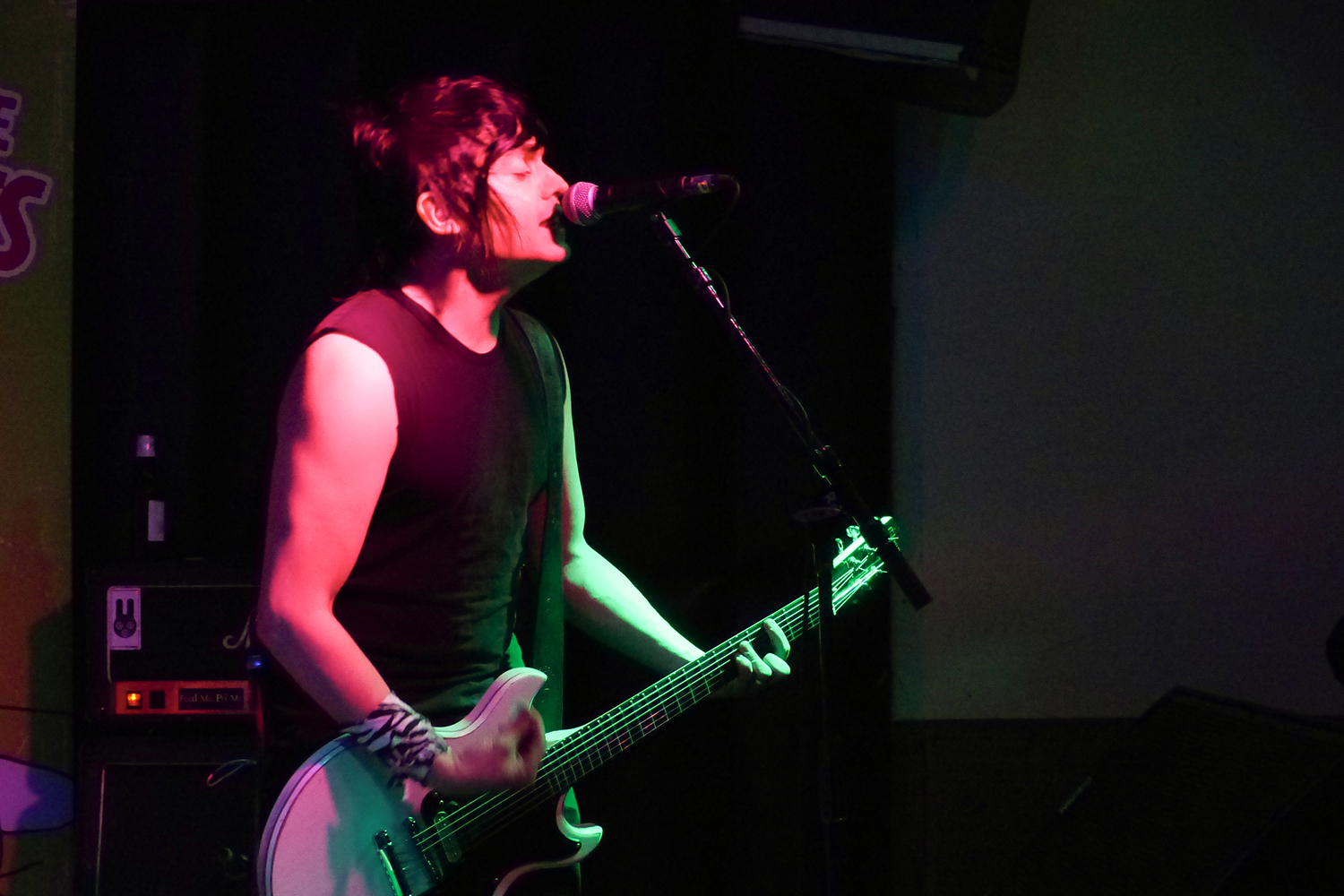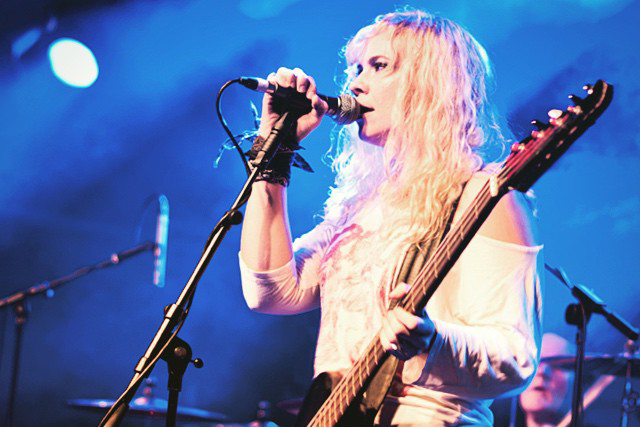“People are smart enough to know if they really want to support us, they’ll come to a show, buy a shirt, or get a copy of the vinyl.”
Musicians with their eyes on the prize tend to have two dreams that they prefer not be mutually exclusive: 1) Make it big, and 2) Make music on their own terms. These days, however, many artists have been leaning more and more towards Option 2 because it affords them better control of their creative destiny — not to mention their bank accounts.
Take The Dollyrots, for example. The L.A.-based garage-punkers were signed to an indie label and scored a moderate hit with 2007’s self-empowerment anthem Because I’m Awesome, but they soon tired of label politics and decided to branch out on their own. Five-plus years into successfully crowdsourcing their subsequent studio and live albums, they haven’t looked back since.

The Dollyrots’ latest PledgeMusic-funded effort, Whiplash Splash, is officially available today on their own Arrested Youth Records label via multiple platforms, although pledgers had their copies in hand a full month ago. From the unabashed whirling-dervish energy of Babbling Idiot to the cheerful defiance of Just Because I’m Blonde — bassist/vocalist Kelly Ogden’s spritely ode to the oft-misunderstood Marilyn Monroe — to the acoustified ’80s nod of This Addiction, The Dollyrots continue to map their own sonic path one power-punk chord at a time.
“When we left our label at the end of 2011, we had seen some other bands we were friends with find success with Kickstarter and the crowdsourcing thing, so we thought, ‘You know what? We can do that too,’” Dollyrots guitarist Luis Cabezas told Digital Trends. “We’d already toured the country, been on many Vans Warped tours, and done the whole punk-rock thing to have built up enough of a following to ask our fans directly if they’d like to support us. And we don’t take their support for granted at all.”
Digital Trends called Cabezas in Los Angeles to discuss how The Dollyrots control their production narrative, the benefits of streaming, and the art of picking the right songs to cover. Just like their signature song says, it’s all because The Dollyrots are awesome.
Digital Trends: You must feel a certain level of satisfaction being able to run your own label thanks to crowdfunding, rather than be beholden to the old-school record-label machine.
Luis Cabezas: Our fanbase is made up of hardcore niche music fans. They’re not casual listeners who find our music by listening to it on the radio or seeing us on TV. They’re people we actually meet at shows! (laughs)
We feel like every single one of those interactions ends up counting because, since we never became a “huge” band, it means that every day, we’re still being discovered by new people. It’s amazing. Some of the messages we’ll get on our Facebook or Twitter are like, “Hey, I’ve been following you guys since 2004.” And every year, there’s more of them, so every single interaction counts.
We just felt like, “Cool — let’s just have our own little niche, and be upfront and honest about it. People will like it.” And that also means we never have to fake it.
And now you get to do things like have that direct ’80s nod to Foreigner’s Waiting for a Girl Like You in Jump Start This Heart. You didn’t hold back on acknowledging that at all.
A song like Jump Start might have gotten resistance from a label, you know? They would be like, “Take out that synth part. It sounds too ’80s.” Well, whatever. We’re like, “Let’s just do whatever we want to do!”
We’re upfront and honest about being in our own niche. That also means we never have to fake it.
That kind of started with [2010’s] A Little Messed Up. We did all the demos for that one at home. That got us started on recording ourselves, and it just kind of progressed from there.
Our co-producer, John Fields, is amazing. He’s always there to help polish it up and make everything better. He just amplifies it, you know? But in terms of the songwriting, the song structures, the words, the tone, and the feel — that’s all stuff Kelly and I do on our own now. We have our own home studio, and we banged out this record in five weeks.
There’s no need to ever overthink it. Things are much better when you don’t overthink them. What’s the quote — that art is never finished until you abandon it? Is that a Bob Dylan quote, or…?
It does sound like a Bob-ism, but I’m not entirely sure. I’ll have to look that up. [It’s actually a Leonardo da Vinci quote: “Art is never finished, only abandoned.”]
That can apply to almost anything: Get it done quickly, and move on to the next thing. Chances are, your first instinct is your best one.
I talk to a lot of artists who agree with that “first thought, best thought” philosophy, and how you can play the feel right out of something if you do too many takes.
There’s something good about the initial thought and the first time something happens. I remember when we tracked Because I’m Awesome live. It was probably only the fourth time we ever played it — and that’s the version that ended up on the record.
For this record, we demo’ed everything at home, and when we were done, we figured we’d take it to Minneapolis and re-record all the guitars and bass with John Fields. But as it turned out, we couldn’t beat the scratch guitars. Even if you can beat them sonically, you can’t beat the feel. When I went back to try and re-record This Addiction, it sounded dead. It just wasn’t as good as the demo.
The ’80s acoustic jangle that opens that song is from the demo?
Yeah. All the guitars were recorded early on, and we just kept them. I felt it was just better that way, and not go back and try to make them perfect. (chuckles)
You do have to keep true to that punk aesthetic, to some degree.
It does have to be somewhat rough around the edges. That can even make it sound bigger sometimes. Everything doesn’t have to be super-quantized. That’s why those old Nirvana records still sound huge.
Right — when you hear that crunch kick in at the outset of Smells Like Teen Spirit, that’s just raw power and the combination of the band and producer Butch Vig working together to get that bigger sound for them.
We couldn’t beat the scratch guitars on the demos. Even if you can beat them sonically, you can’t beat the feel.
Yeah, yeah, totally. I got my hands on some multitracks of some Nirvana riffs that were ripped from Rock Band. It was Very Ape [from 1993’s In Utero], which sounds so loosey-goosey on its own, but when it’s all put together, it sounds so huge. It’s amazing. I love all that stuff — who doesn’t?
I still do. What’s the best way to listen to Dollyrots music — vinyl or digital?
It depends on your environment. If you’re out in the car, on a train, or outside with a lot of ambient noise around you, it’s good to have those digital tracks because they’re super-loud and made for passive listening.
But if you’re actively listening at home on a good set of speakers and really want it to shine, vinyl is the best for that. Vinyl has the dynamics and the warmth, and it doesn’t have to hit your eardrums as hard. Both ways have their purposes.
A lot of people are likely to stream Whiplash Splash. How do you feel about that as both an artist and as the album’s co-producer?
Our philosophy is, we are grateful for every listen. Maybe there are people out there who are potentially going to discover it that way. Like I said before, we’ve never been a huge band, and we always feel like we’re still growing.
When we see a Torrent show on the Internet, it doesn’t really bug us. One, we can control it. Two, I feel like, if somebody truly values us, they’ll find some way to show us some kind of support, you know? In the end, we have all we need. If we need something, we have enough support through our fans that we can do it. We don’t need to “extort” anybody! (laughs)
Streaming is alright. I think it’s cool. People are smart enough to know that if they really want to support us, they’ll come to a show, buy a shirt, or get a copy of the vinyl.

People will vote with their dollars when and where they can. When I’m streaming, I make sure I pay the premium so the artists get something out of it.
And believe me, independent artists like us appreciate that. Truly, I wish the streaming services would pay us more, but I can’t even imagine how little we’d see if we were on a label.
I really love the personalized touches you and Kelly do with all your PledgeMusic goodies.
Ahh, thanks! We want to be able to keep doing this, and we realize that it’s because of the fans that we can. Especially with these Pledge things, we think to ourselves, “OK, what would I want my favorite band ever to do for me? What would make me super-excited to get from them?” Do people want vials of locks of hair? (both laugh) Do they want handwritten lyrics of their favorite song?
Like, if Joey Ramone were here to have written out the lyrics to one of his songs for me, that would have just blown my mind. Or, if he were still around, I would have asked Kurt Cobain to have signed my [Fender] Jag-Stang guitar. I’ve had it since about ’98, and it is so beat up. But that is the sound of every Dollyrots record. I can’t even take that guitar on tour anymore because I’m afraid it’s going to break in half.
I have to say how much I love your Walking on Sunshine cover [of the perpetually sunny Katrina & The Waves hit single from 1985]. I always love how you put your own spin on covers like that. I also like how you’ll just send out free downloads whenever you cover something new.
Sometimes it’s cool to just cover a song, because it teaches me something about songwriting. When you go through a song like that, you’ll discover something new, like, “Wow, I didn’t realize they did it that way — and now I can do that!”
That makes me think of R.E.M., who were masters at writing bridges in their songs. Peter Buck once told me it was something they’d labor over because of how important they felt it was, and yet their bridges come across so effortlessly.
That’s something you may not realize if you’re passively listening — and there is a beauty to passive listening, don’t get me wrong — but that’s why we’ll do Stageit, so that we can learn other people’s songs and debut our versions of them that way.
I feel like it’s a great way for how to learn your craft better. When we did The Beatles Stageit, that was the craziest. We thought doing songs from Meet The Beatles would be easy — all we’d have to do would be to learn three or four chords. But when we went to do it, we found it wasn’t easy at all!
The Beatles always make it sound so easy, but when you break those songs down, you find there’s a lot of structure and craft there.
The more we’ve gotten into recording and producing our own material, the more I respect all that. I’ve also come to respect drums even more. Good drumming is more important than good vocals and good guitars, sadly.
At least you’re a big enough man to admit that. (Cabezas laughs) But if you don’t have a good bass-drum bed track to support them, a lot of songs are just going to fall apart.
Yep. You’ve got to play to the song’s strengths.






